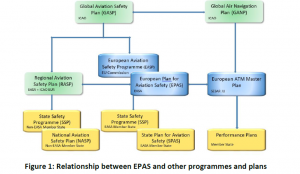By Jenny Beechener
The European Union (EU) has tasked European Aviation Safety Agency (EASA) with the contracting and technical management of research into the vulnerability of manned aircraft to drone strikes under the EU Horizon 2020 programme, commencing this year. Tasks include assessment of the potential collision threats posed by drones to manned aircraft and evaluation of their estimated impacts; establishment of a risk model to support regulatory and operational stances to be validated by means of a comprehensive set of simulated impact tests. A final report is due in 2023.
The information appears in the ninth edition of the European Plan for Aviation Safety (EPAS) published by EASA, which addresses the next regulatory actions relating in particular to the harmonised implementation of the adopted regulations for visual line of sight (VLOS) and beyond visual line of sight (BVLOS) operations. These include new, dedicated implementing and delegated acts relating to ‘open’ and ‘specific’ categories which complement the Implementing Rule (IR) adopted in 2019. Rule-making tasks also apply to the development of necessary regulations for the ‘certified’ category which are due to be drawn up by 2021 followed by IR in 2022 and adoption by 2023. This applies to UAS cargo, UAS operations in urban environments, and operations with manned vertical take-off and landing (VTOL).
The EPAS publication also gives details of the Counter Drone (C-UAS) Task Force action plan.
EASA established a C-UAS task force in 2019 and acts as the European coordinator of a roadmap to be developed and implemented with all involved stakeholders. EPAS 2020-2024 identifies a number of actions as part of this activity:
- Educate the public to prevent and reduce misuse of drones around aerodromes
Provide a common digital format to be used by Member States to make UAS geographical zones available to the public. Due 2Q20
- Prepare aerodromes to mitigate risks from unauthorised drones use
Manual with best practices on definition of roles and responsibilities when unauthorised drones are identified in the vicinity of an aerodrome. Due 3Q20
- Support the assessment of the safety risk of drones to manned aircraft with scientific data
Report gathering scientific data. Workshop 1Q20
- Ensure C-UAS measures are swiftly considered and implemented from a global safety perspective
Release guidance material and clarify roles and responsibilities of stakeholders. Due 2Q20
- Support adequate occurrence reporting
Define criteria to classify an airprox between a UAS and a manned aircraft; and a UAS airspace infringement. Due 4Q20
EPAS 2020-2024 is drawn up in close collaboration with its various stakeholders and lays out the current and future work EASA will be undertaking in coming years to support the introduction of new technologies and innovative solutions. It provides a framework for safety management at regional and State level, supporting the goals and objectives of the ICAO Global Aviation Safety Plan (GASP). It sets out the strategic priorities, strategic enablers and main risks affecting the European aviation system and the necessary actions to mitigate those risks and to further improve aviation safety.
The publication says: “Member States will need to modify already adopted national regulations” to the ensure safe integration of civil unmanned aircraft systems in the aviation system. EASA says safe integration of all new entrants into the airspace network is one of the main challenges in relation to the integration of UAS technologies and related concepts of operation.

Following the publication of EU regulations defining the technical requirements for drones in 2019, EASA, EPAS 2020-204 confirms previous edition’s planning milestones for the development of a high-level regulatory framework on U-space. EASA’s opinion on this is expected in 1Q2020 and is due to be adopted in 2021.
The plan also sets out tasks relating to “safety promotion on civil drones” including the release of safety promotion material by 2021 and “coordinated European activity to promote safe operation of drones to the general public”.
These measures are among a series of rule-making tasks due to take place between 2020 and 2025 covering different drone types and capabilities, including the development of detect and avoid systems. The actions complement adopted regulations and are necessary to enable concepts such as urban air mobility and drone operations to take place with the aim of improving the level of safety whilst creating a level playing field for new business models and operating concepts.
This edition contains 180 EPAS actions designed to improve air traffic management, address cybersecurity threats and to develop safety requirements in the area ground-handling. The agency’s roadmaps, proposing coordinated actions in areas such as artificial intelligence, rotorcraft or general aviation are an integral part of EPAS. The five-year plan sets out the strategic priorities, strategic enablers and main risks affecting the European aviation system and the necessary actions to mitigate those risks and to further improve aviation safety.
For more information visit:
www.easa.europa.eu/document-library/general-publications/european-plan-aviation-safety-2020-2024
(Image: IgorZh/Shutterstock)




